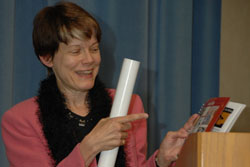 |
Julia Royall of NLM offers a mid-term report on her Fulbright year in Uganda.
|
Royall came to NLM in 1997 to create a malaria research telecommunications network to support scientists in Africa. Her current project, funded by her 2007-2008 Fulbright fellowship and NLM, is investigating whether an “information intervention” can make a difference in health.
“What do you think of when you think of Africa?”
she asked in opening
remarks. “Famine, tyranny,
heroism, AIDS, civil war—or celebrity humanitarians?
And what is NLM’s role? Where do we fit in?”
Now at the midpoint of her fellowship, Royall
has found three ways to fit in. First, there’s library outreach—teaching Ugandan librarians
to teach graduate students to search NLM databases. Then there’s work with medical students
to deploy the MedlinePlus malaria tutorial
in health centers, district health offices and NGOs (nongovernment organizations). Finally, there’s partnering with a village project in eastern
Uganda as well as Kabala University in the west—the first university founded and led by Ugandans, not Europeans, she noted.
 |
 |
Left:
Royall meets with Makerere medical students and collaborators
(from l) William Lubega, Nelson Igaba and Nixon Niyonzima. Right:
Royall describes life “in country.”
Above Left Photo Courtesy Julia Royall and Jack Kyrieleison
NIH Photos: Michael Spencer |
She also plans to work in the northern region, an area long wracked by civil war and the rebel guerrilla Lord’s Resistance Army. “I actually won’t be steering clear, but won’t be taking risks,” she said. “The area where I work now is peaceful.”
Meanwhile, she has a life: “in country” with her is son Owen, age 16. They are billeted on the main campus of Makerere University in Kampala,
not far from Lake Victoria.
Globally, each year there are an estimated 300 million-500 million malaria cases and more than a million reported deaths, 90 percent of which occur in sub-Saharan Africa. Royall noted that experts on NLM’s Africa Advisory Board, not staff at NLM, decided what diseases MedlinePlus
for Africa would address: these include AIDS, tuberculosis and malaria.
Furthermore, she continued, the malaria tutorials
were produced with “local talent.”
“We had to be careful,” she said, “about working
with these communities to define what the products would look like. The academic approach fell away.”
The tutorials were originally produced in collaboration
with medical faculty at Makerere University
and a team of Ugandan doctors, medical students, artists and translators. The malaria tutorial was then field-tested in villages by the students and translated into three local languages:
Luganda, Rukiga and Luo.
The context was tough: frequent power outages;
roads more potholed than passable; a 70 percent literacy rate; and belief in local healers
to the exclusion of medical science. Uganda,
a landlocked country in East Africa, has for decades been riven by postcolonial strife, war, poverty and disease. Yet Royall was at pains to show the hope.
“ICT [information and telecommunications] interventions,” she said, “are making a difference
at the village level.” Makerere University medical students “took the lead in making and distributing booklets, posters and audio CD formats to be used on the radio, an important communication tool in Africa.”
She showed a clip featuring fourth-year students
working in an area that has only one doctor
for 50,000 people. One student, William Lubega, said: “This program first of all should be integrated into our curriculum...Every year as students go out into the communities, they can share this knowledge.” Nixon Niyonzima added:
“The idea [is] empowering the community themselves to teach the rest of the community to prevent malaria.”
All agreed that the power of visual imagery is paramount.
Future research modules will include diarrhea, addiction and nutrition. “Uganda has lots of good food and lots of malnourished kids,” Royall said.
Can health messages change behavior? To measure
impact, a baseline survey on the malaria project in one of the villages is now in process.
“When I come back [to NLM in June],” Royall said, “I’ll report on it.”
For more information on the tutorials, visit www.nlm.nih.gov/medlineplus/africa/. 